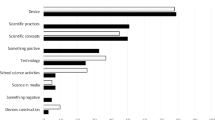Abstract
We examine the research conducted by Kang, Anderson and Wu by discussing it in a larger context of science museum-school partnerships. We review how the disconnect that exists between stakeholders, the historical and cultural contexts in which formal and informal institutions are situated, and ideas of globalization, mediate the success for formal-informal partnerships to be created and sustained.
Similar content being viewed by others
References
Anderson, D., Kisiel, J., & Storksdieck, M. (2006). School field trip visits: Understanding the teacher’s world through the lens of three international studies. Curator, 49, 365–386.
Astor-Jack, T., McCallie, E., & Balcerzak, P. (2007). Academic and informal science education practitioner views about professional development in science education. Science Education, 91, 604–628.
Grossman, P. G., Wilson, S. M., & Shulman, L. S. (1989). Teachers of substance: The subject matter knowledge of teachers. In M. Reynolds (Ed.), The knowledge base for beginning teachers (pp. 23–36). New York: Pergamon.
Hudson, K. (1987). Museums of influence. Cambridge: Cambridge University Press.
Kang, C., Anderson, D., & Wu, X. (2009). Chinese perceptions of the interface between school and museum education. Cultural Studies of Science Education.
Kisiel, J. F. (2005). Understanding elementary teacher motivations for science field trips. Science Education, 89, 936–955.
Koster, E., & Falk, J. (2007). Maximizing the external value of museums. Curator, 50, 191–196.
Kuhn, T. (1962). The structure of scientific revolutions. Chicago: University of Chicago Press.
Lave, J., & Wenger, E. (1991). Situated learning: Legitimate peripheral participation. UK: Cambridge University Press.
Lemke, J. (2001). Articulating communities: Sociocultural perspectives on science education. Journal of Research in Science Teaching, 38, 296–316.
Ogawa, R. T., Loomis, M., & Crain, R. (2009). Institutional history of an interactive science center: The founding and development of the exploratorium. Science Education, 93, 269–292.
Osborne, H. F. (1927). Creative education in school, college, university and museum. New York: Charles Scribner’s Sons.
Roth, W. M., & Lee, Y. J. (2007). “Vygotsky’s neglected legacy”: Cultural historical activity theory. Review of Educational Research, 77, 186–232.
Roth, W.-M., & Tobin, K. (2004). Co-generative dialoguing and metaloguing: Reflexivity of processes and genres. [35 paragraphs]. Forum Qualitative Sozialforschung/Forum: Qualitative Social Research [On-line Journal], 5(3). Available at: http://www.qualitative-research.net/index.php/fqs/article/view/560/1214. [Access: February 28, 2010].
Rudolph, J. (2002). Scientists in the classroom: The Cold War reconstruction of American science education. New York: Palgrave.
Smith, F., Hardman, F., Wall, K., & Mroz, M. (2004). Interactive whole class teaching in the national literacy and numeracy strategies. British Educational Research Journal, 30, 395–411.
Toon, R. (2007). Science centres: A museum studies approach to their development and possible future direction. In S. J. Knell, S. MacLeod, & S. E. R. Watson (Eds.), Museum revolutions: How museums change and are changed (pp. 105–116). London: Routledge.
Tran, L. U. (2007). Teaching science in museums: The pedagogy and goals of museum educators. Science Education, 91, 278–297.
Wenger, E. (1998). Communities of practice: Learning, meaning and identity. New York: Cambridge University Press.
Author information
Authors and Affiliations
Corresponding author
Rights and permissions
About this article
Cite this article
Gupta, P., Adams, J., Kisiel, J. et al. Examining the complexities of school-museum partnerships. Cult Stud of Sci Educ 5, 685–699 (2010). https://doi.org/10.1007/s11422-010-9264-8
Received:
Accepted:
Published:
Issue Date:
DOI: https://doi.org/10.1007/s11422-010-9264-8




